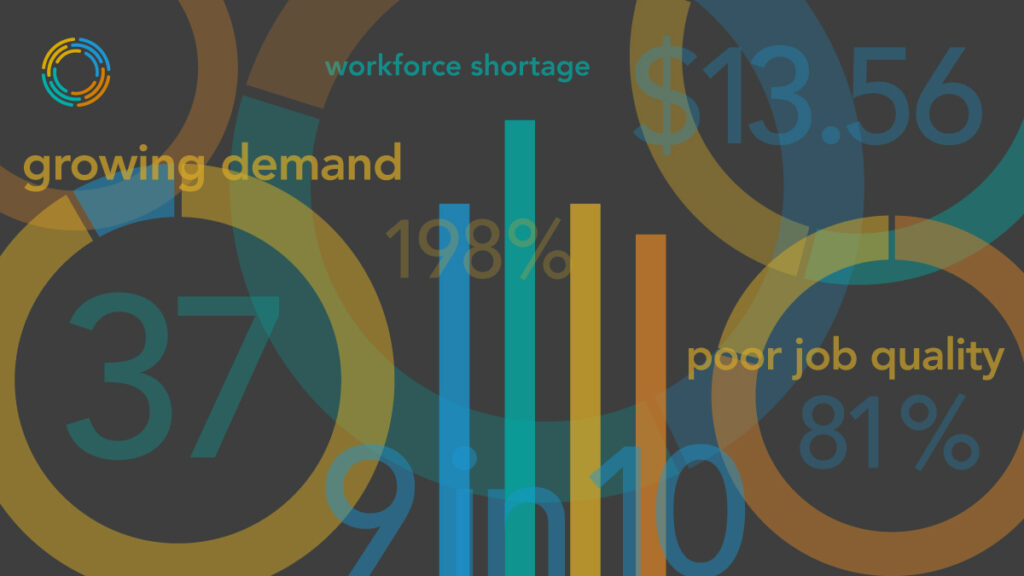8 Essential Publications on the Direct Care Workforce

The COVID-19 pandemic and the potential for large-scale federal investment in the care economy have raised significant interest in direct care workers to an unprecedented level.
These two developments underscore a clear reality: though millions of direct care workers provide critical daily support to older adults and people with disabilities, their jobs are often unfairly characterized by low compensation, inadequate training, insufficient advancement opportunities, and other challenges rooted in poor job quality. As a result, workers can’t make ends meet and often leave this sector, threatening consumers’ access to care.
For 30 years, PHI’s research and analysis have helped policy and practice leaders better understand this workforce, including the types of interventions that will help address this growing workforce crisis. Here are eight of our essential publications from recent years.
CARING FOR THE FUTURE

Caring for the Future: The Power and Potential of America’s Direct Care Workforce (Jan 2021)
What will it take for our country to transform the direct care workforce? This question has become more urgent during the COVID-19 pandemic, as millions of workers have been on the frontline of this crisis yet without the support they deserve. This in-depth report tackles this question by offering a comprehensive, current-day analysis of the direct care workforce and its critical role in the long-term care system. The report also outlines a detailed slate of concrete recommendations for policymakers, employers, and other stakeholders. Read it here.
RESEARCH REPORT

Direct Care Workers in the United States: Key Facts (Sep 2021)
Every year, PHI releases a statistical snapshot of the direct care workforce with key figures on demographics, job quality challenges, and projected job openings—with detailed findings on home care workers, residential care aides, and nursing assistants in nursing homes. Our most recent report showed that the direct care workforce expanded rapidly over the last decade, growing from 3.1 million workers in 2010 to 4.6 million in 2020 (among many other findings). Read it here.
COVID-DISPLACED WORKERS

Workforce Displacement and Re-Employment During the COVID-19 Pandemic (Oct 2021)
How many direct care workers were displaced during the first three months of the COVID-19 pandemic, and did they re-enter the labor force into direct care occupations? These were only two questions posed in a 2021 study by PHI and the Health Workforce Research Center on Long-Term Care at the University of California, San Francisco. Among other findings, the study found that 4 percent of direct care workers were displaced during the second quarter of 2020, and an immeasurably small number of displaced workers (from direct care or any other occupation) were re-employed into direct care. Read it here.
PAID CAREGIVERS IN ARIZONA

Insights from the Frontline: Results of a Statewide Survey of Paid Caregivers in Arizona (Aug 2021)
To fully understand the challenges facing direct care workers—and how to solve them—researchers must reach out directly to workers. In 2020, PHI partnered with four managed care organizations in Arizona to survey more than 4,000 paid caregivers in the state about their experiences and insights. Released in August 2021, the findings show that various factors influence workers’ longevity in the field, including compensation, training, supervision, opportunities for advancement, and support during the COVID-19 pandemic, among others. Read it here.
FEDERAL POLICY PRIORITIES

Federal Policy Priorities for the Direct Care Workforce (Jul 2021)
To support a new presidential administration, we released a federal report with nearly 40 concrete recommendations for the White House, Congress, and key federal departments and agencies. The report’s recommendations span eight issue areas that are key to transforming jobs for this rapidly growing sector: financing, compensation, training, workforce interventions, data collection, direct care worker leadership, equity, and the public narrative. Read it here.
LOCALIZED STRATEGIES

Localized Strategies for Addressing the Workforce Crisis in Home Care (Nov 2019)
While resolving the direct care workforce crisis will require concerted action at the state and national levels, there is also an important role for local governments and stakeholders to play. This issue brief presents a range of localized strategies for strengthening the home care workforce, along with real-world examples. Read it here.
THE FUTURE OF HOME CARE

Envisioning the Future of Home Care: Trends and Opportunities in Workforce Policy and Practice (Oct 2019)
As the U.S. population lives longer and grows older, more individuals will require support to continue living independently in their homes and communities—and yet the home care sector might be unprepared to meet this demand. How can we strengthen the home care workforce and improve home care access and quality for consumers in the years ahead? This report describes the current and projected home care landscape—focusing on consumers, workers, and the sector—and builds a vision for the future of home care services in the United States. The report culminates with recommendations for achieving this vision. Read it here.
RECRUITMENT & RETENTION

Growing a Strong Direct Care Workforce: A Recruitment and Retention Guide for Employers (May 2018)
What are the best ways to find and keep direct care workers in long-term care? This is a common question from long-term care employers that reflects their concerns about filling vacant jobs and reducing turnover, whether providing care in nursing homes or in the community. It’s also a question that PHI is well-equipped to answer, given our three decades of experience in the field. This guide provides employers with 10 practical strategies for recruiting and retaining direct care workers. Read it here.
Scroll through PHI’s entire publication library.





